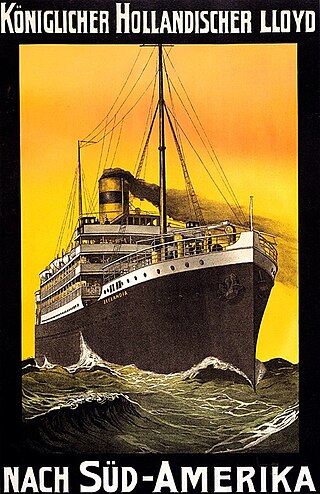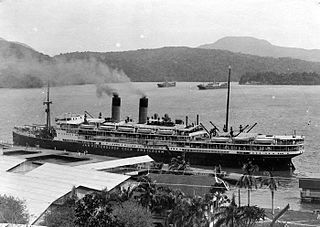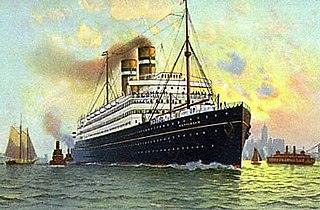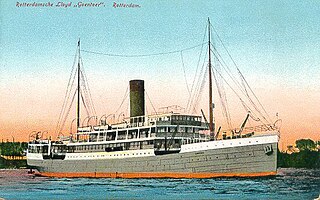
Stoomvaart Maatschappij Nederland or SMN, also known as the Netherland Line or Nederland Line, was a Dutch shipping line that operated from 1870 until 1970, when it merged with several other companies to form what would become Royal Nedlloyd.

SS Dwinsk was a transatlantic ocean liner that was launched in Ireland in 1897 as Rotterdam, renamed C. F. Tietgen in 1906, and renamed Dwinsk in 1913. A U-boat sank her in 1918, with the loss of 23 lives. The ship was built for Holland America Line, but was successively owned by Scandinavian America Line and Russian American Line, and after the Russian Revolution she was managed by Cunard Line.

SS Potsdam was a steam ocean liner that was launched in Germany in 1899 for Holland America Line. In 1915 Swedish American Line acquired her and renamed her Stockholm.

SS Noordam was a steam ocean liner that was launched in Ireland in 1901 and scrapped in the Netherlands in 1928–29. Holland America Line owned her throughout her career. From 1923 to 1924 Swedish American Line chartered her and renamed her Kungsholm.

USS Bali was a Dutch cargo steamship that was built for Stoomvaart Mattschappij Nederland in 1917. She served in the United States Navy, with the ID number ID–2483, from March 1918 until May 1919. She supplied the American Expeditionary Forces in France, and in 1919 she took food relief to Europe.

USS Zeelandia was an ocean liner that was built in Scotland in 1910 and scrapped in the Netherlands in 1936. She was the largest ship in the Koninklijke Hollandsche Lloyd (KHL) fleet from 1910 until the liners Gelria and Tubantia were completed in 1913 and 1914. She was USS Zeelandia from April 1918 until October 1919, when she was a United States Navy troopship.

SS Statendam was a transatlantic ocean liner that was launched in Ireland in 1898 for Holland America Line. She was the first of several ships in the company's history to be called Statendam. She was NASM's first ship of more than 10,000 GRT, and she was the largest ship in the company's fleet until Potsdam was completed in 1900.

USS Rondo (ID-2488) was a Dutch cargo steamship that was built for Stoomvaart Mattschappij Nederland in 1914. She served in the United States Navy from March 1918 until June 1919. She was scrapped in 1933.

USS Oosterdijk was a Holland America Line cargo steamship that was built in 1913 and sank as a result of a collision in 1918. She served in the United States Navy, with the Naval Registry Identification Number ID–2586, from March 1918 until her loss that July. Some sources anglicise her name as Oosterdyk, but Lloyd's Register registered her with the Dutch spelling Oosterdijk.

SS Polar Chief was a merchant steamship that was built in England in 1897 and scrapped in Scotland in 1952. In its 55-year career it had previously been called Montcalm, RFA Crenella, Crenella, Rey Alfonso, Anglo-Norse and Empire Chief. Early in the First World War it spent eight months pretending to be the battleship HMS Audacious.

HNLMS Koningin Wilhelmina der Nederlanden was a unique protected cruiser of the Royal Netherlands Navy built by the Rijkswerf in Amsterdam.
SS Binnendijk was a Holland America Line (NASM) cargo steamship. She was one of NASM's "B" class ships: the company's first cargo ships to be powered by steam turbines. Binnendijk was built in South Holland in 1921, and sunk by a mine in the English Channel in 1939. She was the first ship that NASM lost in the Second World War. Her wreck off the coast of Dorset, England is now a wreck diving site, nicknamed "The Benny".

SS Ophir was a Dutch steamship that was built in 1904. She carried passengers, cargo and mail between Rotterdam and the Dutch East Indies until March 1918, when the United States seized her under angary and she became USS Ophir (ID-2800). In November 1918 a fire and explosion damaged her beyond economic repair. She was scrapped in 1922.

SS Jan Pieterszoon Coen was a Dutch passenger steamship that was launched in 1914. She was named after a former Governor-General of the Dutch East Indies. During the German invasion of the Netherlands in May 1940 she was scuttled as a blockship in the port of IJmuiden, North Holland to prevent the Kriegsmarine from using the port.

SS Rotterdam was a steam ocean liner that was launched and completed in Ireland in 1908, and scrapped in the Netherlands in 1940. Holland America Line (HAL) owned and operated her throughout her career. She was the fourth of seven HAL ships to have been named after the Dutch city of Rotterdam. Until Statendam entered service in 1929, Rotterdam was the largest and swiftest ship in the company's fleet, and was the company's flagship.

SS Costa Rica was a Dutch passenger steamship. She was built in 1910 as Prinses Juliana for Stoomvaart Maatschappij Nederland, which ran scheduled passenger and mail services between Amsterdam and Java.

SS Aquileia was a Dutch-built steamship that was launched in 1913 as the ocean liner and mail ship Prins der Nederlanden for Netherland Line. She ran scheduled services between Amsterdam and the Dutch East Indies until 1930, when she was laid up.

SS Goentoer was a Dutch passenger and mail ship that was built for Rotterdamsche Lloyd in 1902 and scrapped in 1925. Her regular route was between Rotterdam and the Dutch East Indies. She was a UK troop ship from 1918 to 1919, after being seized under angary in Singapore.

SS Westerdijk was a Holland America Line cargo steamship that was completed in 1913 and scrapped in 1933. She served in the United States Navy, with the Naval Registry Identification Number ID–2514, from March 1918 until September 1919. Some sources anglicise her name as Westerdyk, but Lloyd's Register registered her with the Dutch spelling Westerdijk.

SS Har Zion was a passenger and cargo steamship that was built in Denmark in 1907 as St. Jan for Det Østasiatiske Kompagni. In 1913 Koninklijke Nederlandse Stoomboot-Maatschappij bought her and renamed her Nickerie. In 1933 Ignazio Messina & Co bought her and renamed her Risveglio. In 1935 Palestine Maritime Lloyd bought her and renamed her Har Zion.























